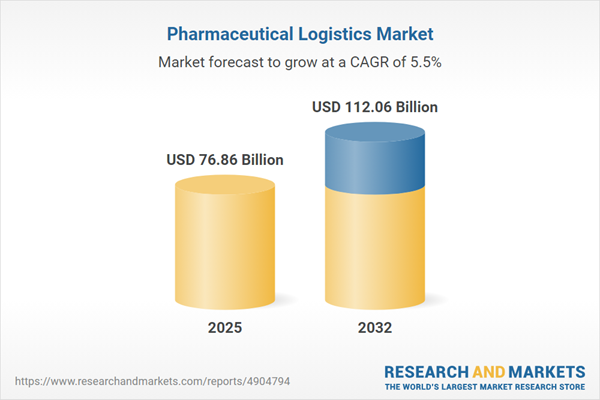Speak directly to the analyst to clarify any post sales queries you may have.
The pharmaceutical logistics market is evolving rapidly as industry leaders navigate increasing regulatory complexity, technology adoption, and global distribution demands. Modern supply chains now require a strategic approach to efficiency, traceability, and sustainability to support critical healthcare delivery.
Market Snapshot: Pharmaceutical Logistics Market Size and Growth
The Pharmaceutical Logistics Market grew from USD 73.12 billion in 2024 to USD 76.86 billion in 2025. It is expected to continue growing at a CAGR of 5.48%, reaching USD 112.06 billion by 2032. Strong growth is attributed to advanced cold chain requirements, digital transformation, and expanding last-mile delivery for sensitive pharmaceutical products.
Scope & Segmentation of the Pharmaceutical Logistics Market
This market research provides a comprehensive view of how companies and providers are structuring logistics networks worldwide. Segmentation enables tailored solutions in response to varying product, regulatory, and technological requirements across geographies. The following coverage areas are included:
- Type: Cold Chain Logistics, Non-Cold Chain Logistics
- Component: Distribution, Monitoring, Packaging, Storage & Warehousing
- Product: Biologic Products (Monoclonal Antibodies, Peptides, Proteins), Branded Drugs, Generic Pharmaceuticals (Over-The-Counter, Prescription Generics)
- Mode of Transport: Air Freight (Charter Services, Commercial Cargo), Road Transportation (Rail, Trucking), Sea Freight (Container Shipping, Roll-On/Roll-Off)
- Application: Bio Pharma, Chemical Pharma, Specialized Pharma
- End User: Healthcare Providers, Pharmaceutical Manufacturing, Research Institutions
- Key Regions: Americas (United States, Canada, Mexico, Brazil, Argentina, Chile, Colombia, Peru), Europe, Middle East & Africa (including United Kingdom, Germany, France, Russia, Italy, Spain, Netherlands, Sweden, Poland, Switzerland, United Arab Emirates, Saudi Arabia, Qatar, Turkey, Israel, South Africa, Nigeria, Egypt, Kenya), Asia-Pacific (China, India, Japan, Australia, South Korea, Indonesia, Thailand, Malaysia, Singapore, Taiwan)
- Leading Companies: A.P. Møller – Mærsk A/S, Air Canada, AIT Worldwide Logistics, Almac Group, AWL India, Bilcare, C.H. Robinson, Catalent, Cencora, CEVA Logistics, Clinigen Group, Crown LSP Group, DHL International (Deutsche Post), DSV A/S, FedEx, ICON PLC, Infosys, Kerry Logistics, Kuehne + Nagel, Lineage, Lonza, Movianto, NextPharma Logistics, Nippon Express, Parexel, SEKO Logistics, SF Express, Thermo Fisher Scientific, UPS, Yusen Logistics
- Technology Use: Internet of Things, blockchain traceability, real-time monitoring, predictive analytics, machine learning, automated warehousing, sustainable packaging solutions
Key Takeaways for Senior Decision-Makers
- Digital transformation is driving increased adoption of real-time tracking, predictive analytics, and automation across the supply chain, allowing for proactive risk management and enhanced transparency.
- As temperature-sensitive drugs and biologics proliferate, investment in advanced cold chain infrastructure is essential to maintain product safety and compliance across global networks.
- Scaling operations to meet global demand requires both regional hubs and localized micro-fulfillment models, optimizing efficiency and responsiveness to patient needs.
- Strategic partnerships—between logistics providers, technology specialists, and local distribution networks—are key for navigating complex regulatory environments and accelerating market access.
- Sustainability imperatives have accelerated the adoption of eco-friendly packaging and low-emission logistics, responding to operational efficiency goals and growing stakeholder expectations for responsible practices.
- Service innovation hinges on a keen understanding of product-specific handling and transport requirements, with stakeholders collaborating across the value chain for end-to-end reliability.
Tariff Impact: Navigating Shifting Cost Pressures in the US
Adjusted US tariff structures beginning in 2025 have heightened cost pressures across the pharmaceutical logistics sector. Companies are refining sourcing strategies, expanding domestic partnerships, and renegotiating cross-border agreements. Regional distribution hubs and closer alliances with freight forwarders are being established to consolidate shipments, streamline customs, and reduce exposure to increased import duties.
Methodology & Data Sources
This research is built on a robust, multi-method approach combining executive interviews, secondary data from reputable industry sources, and expert validation. Comprehensive market mapping and triangulation methodologies ensure high data accuracy and relevance for today’s senior supply chain strategists.
Why This Report Matters
- Enables organizations to benchmark logistics networks and investments against leading practices and peer strategies.
- Provides actionable insights into technology adoption, operational model adjustments, and sustainability planning informed by regulatory shifts.
- Supports scenario planning for tariff impacts, cross-market compliance, and tailored supply chain execution strategies.
Conclusion
The Pharmaceutical Logistics Market is transforming through digital innovation, regulatory changes, and evolving distribution models. Senior leaders who leverage targeted insights and invest in capability upgrades are positioned to optimize efficiency, ensure compliance, and deliver reliable healthcare solutions worldwide.
Additional Product Information:
- Purchase of this report includes 1 year online access with quarterly updates.
- This report can be updated on request. Please contact our Customer Experience team using the Ask a Question widget on our website.
Table of Contents
3. Executive Summary
4. Market Overview
7. Cumulative Impact of Artificial Intelligence 2025
Companies Mentioned
The companies profiled in this Pharmaceutical Logistics market report include:- A.P. Møller – Mærsk A/S
- Air Canada
- AIT Worldwide Logistics, Inc.
- Almac Group
- AWL India Private Limited
- Bilcare Limited
- C.H. Robinson Worldwide, Inc.
- Catalent, Inc.
- Cencora Inc.
- CEVA Logistics
- Clinigen Group PLC
- Crown LSP Group
- DHL International GmbH by Deutsche Post AG
- DSV A/S
- FedEx Corporation
- ICON PLC
- Infosys Limited
- Kerry Logistics Network Limited
- Kuehne + Nagel International AG
- Lineage, Inc.
- Lonza Group Ltd.
- Movianto Group
- NextPharma Logistics GmbH
- Nippon Express Co., Ltd.
- Parexel International Corporation
- SEKO Logistics
- SF Express Co., Ltd.
- Thermo Fisher Scientific, Inc.
- United Parcel Service of America, Inc.
- YUSEN LOGISTICS CO., LTD.
Table Information
| Report Attribute | Details |
|---|---|
| No. of Pages | 198 |
| Published | November 2025 |
| Forecast Period | 2025 - 2032 |
| Estimated Market Value ( USD | $ 76.86 Billion |
| Forecasted Market Value ( USD | $ 112.06 Billion |
| Compound Annual Growth Rate | 5.4% |
| Regions Covered | Global |
| No. of Companies Mentioned | 31 |









